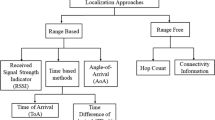Abstract
This paper proposes a distributed dynamic k-medoid clustering algorithm for wireless sensor networks (WSNs), DDKCAWSN. Different from node-clustering algorithms and protocols for WSNs, the algorithm focuses on clustering data in the network. By sending the sink clustered data instead of practical ones, the algorithm can greatly reduce the size and the time of data communication, and further save the energy of the nodes in the network and prolong the system lifetime. Moreover, the algorithm improves the accuracy of the clustered data dynamically by updating the clusters periodically such as each day. Simulation results demonstrate the effectiveness of our approach for different metrics.
Similar content being viewed by others
References
Heinzelman W B, Chandrakasan A P, Balakrishnan H. Energy Efficient Communication Protocol for Wireless Microsensor Networks [C] // Proceedings of the 33rd Hawaii International Conference on System Sciences. Washington, D C: IEEE Computer Society, 2000: 3005–3014.
Heinzelman W B, Chandrakasan A, Balakrishnan H. An Application-Specific Protocol Architecture for Wireless Microsensor Networks [J]. IEEE Trans Wireless Communication, 2002, 1(4): 660–670.
Manjeshwa R A, Agrawal D. TEEN: a Protocol for Enhanced Efficiency in Wireless Sensor Networks [C] // Proceedings of the 1st International Workshop on Parallel and Distributed Computing Issues in Wireless Networks and Mobile Computing. New York: ACM Press, 2001: 304–309.
Arati M, Dharma P A. APTEEN: a Hybrid Protocol for Efficient Routing and Comprehensive Information Retrieval in Wireless Sensor Networks [C] // Proceedings of the 2nd International Workshop on Parallel and Distributed Computing Issues in Wireless Networks and Mobile Computing. Fort Lauderdale, Washington D C: IEEE Computer Society, 2002: 195–202.
Lindsey S, Raghavendra C. PEGASIS: Power Efficient Gathering in Sensor Information Systems [C] // Proceedings of the IEEE Aerospace Conference, Montana: IEEE, 2002: 1125–1130.
Yonis O. HEED: A Hybrid, Energy-Efficient, Distributed Clustering Approach for Ad-hoc Sensor Networks [J]. IEEE Trans on Mobile Computing, 2003, 3(4): 366–379.
Arjan D, Vamsi P, Leonard B. Delay-Energy Aware Routing Protocol for Sensor and Actor Networks [J]. Proceedings of ICPADS 2005 IEEE, 2005, 1: 292–298.
Antonio G R, Richard T. An Energy-Efficient and Low-latency Routing Protocol for Wireless Sensor Networks [C] // Proceedings of the 2005 Systems Communications (ICW′05, ICHSN′05, ICMCS′05, SENET′05), Washington D C: IEEE Computer Society, 2005: 449–454.
Hulten G, Spencer L. Mining Time-Changing Data Streams [C] // Proceedings of the ACM Conference on Knowledge and Data Discovery (SIGKDD). New York: ACM Press, 2001: 97–106.
Aggarwal C C, Han J, Wang J, et al. A Framework for Clustering Evolving Data Streams [C] // Proceedings of the 29th VLDB Conference. Berlin: VLDB Press, 2003: 81–92.
Brian B, Mayur D, Rajeev M, et al. Maintaining Variance and K-medians over Data Stream Windows [C] // ACM SIGMOD Principles of Database Systems (PODS). New York: ACM Press, 2003: 234–243.
Jessica L, Michail V, Eamonn K, et al. Iterative Incremental Clustering of Time Series [C] // Proceedings of the IX Conference on Extending Database Technology (EDBT 2004). Washington D C: IEEE Computer Society, 2004: 333–342.
Dhillon I, Modha D. A Data-Clustering Algorithm on Distributed Memory Multiprocessors [C] // Proceeding of the KDD′99 Workshop on High Performance Knowledge Discovery. Berlin: Springer Verlag, 1999: 245–260.
Kargupta H, Huang W, Sivakumar K, et al. Distributed Clustering Using Collective Principal Component Analysis [J]. Knowledge and Information Systems Journal, 2001, 3: 422–448.
Matthias K, Stefano L, Gianluca M. Distributed Clustering Based on Sampling Local Density Estimates [C] // Proceedings of the Joint International Conference on AI. Mexico: Morgan Kaufmann Press, 2003: 485–490.
Eisenhardt M, Muller W, Henrich A. Classifying Documents by Distributed P2P Clustering [C] // Proceedings of Informatics. Berlin: Springer Verlag, 2003: 286–291.
Aleksandar L, Dragoljub P, Zoran O. Distributed Clustering and Local Regression for Knowledge Discovery in Multiple Spatial Databases [C/OL] // Proceedings of the 8th European Symposium on Artificial Neural Networks. [2006-11-20]. http://www.dice.ucl.ac.be/Proceedings/esann/esannpdf/es200-0-20.pdf .
Fred A F N, Jain A K. Data Clustering Using Evidence Accumulation [C] // Proceedings of the International Conference on Pattern Recognition. Berlin: Springer Verlag, 2002: 276–280.
Author information
Authors and Affiliations
Corresponding author
Additional information
Foundation item: Supported by the National Natural Science Foundation of China (60472047)
Biography: WANG Leichun (1974–), male, Ph.D. candidate, research direction: wireless communication.
Rights and permissions
About this article
Cite this article
Wang, L., Chen, S. & Hu, R. A distributed dynamic clustering algorithm for wireless sensor networks. Wuhan Univ. J. Nat. Sci. 13, 148–152 (2008). https://doi.org/10.1007/s11859-008-0205-2
Received:
Published:
Issue Date:
DOI: https://doi.org/10.1007/s11859-008-0205-2




